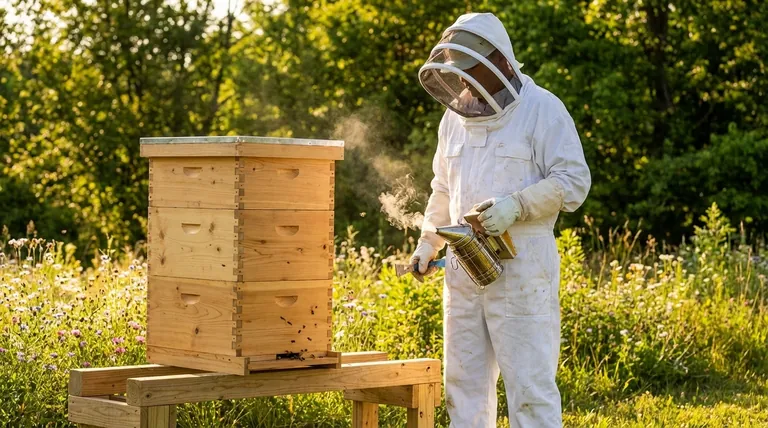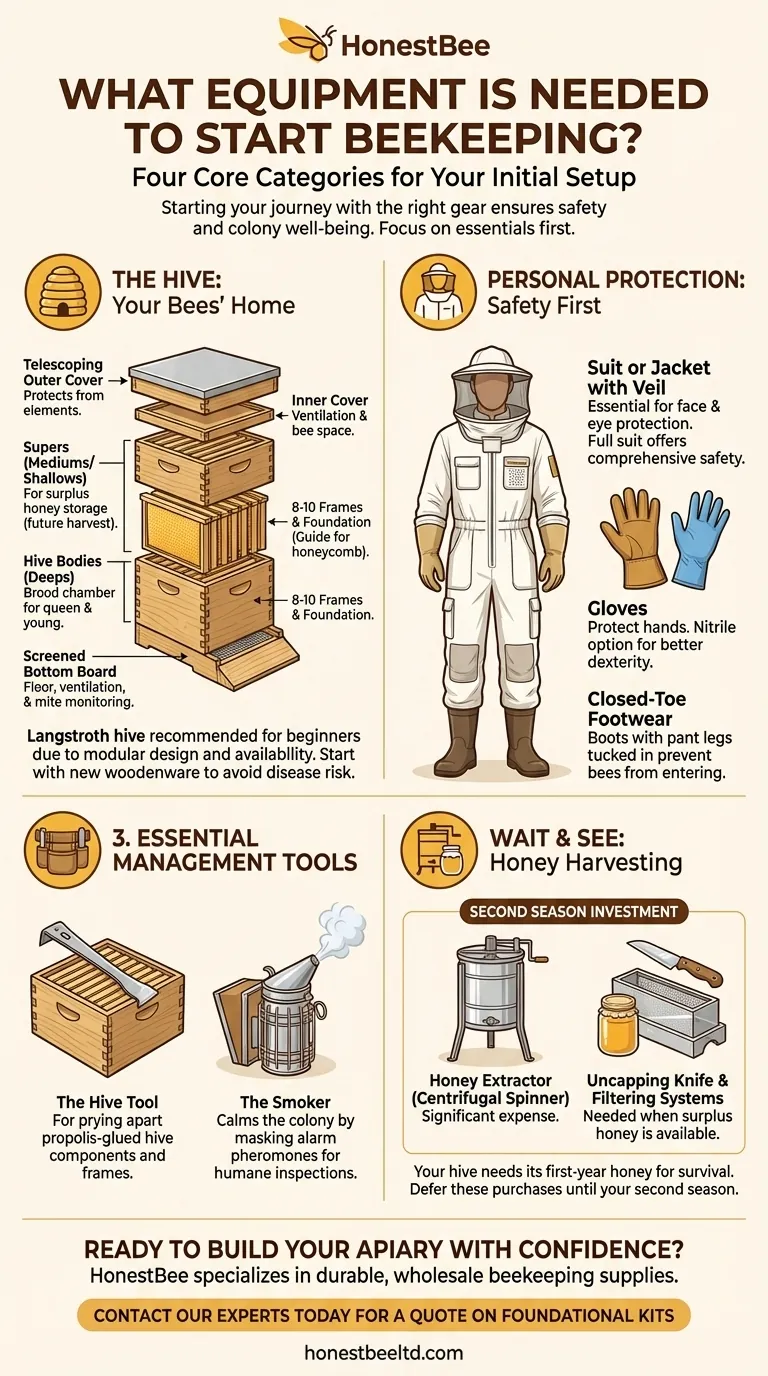Starting your beekeeping journey is an exciting prospect, and success begins with the right equipment. To begin, you will need four core categories of gear: the hive itself, personal protective clothing, essential management tools like a smoker and hive tool, and eventually, equipment for harvesting honey. This initial setup ensures the safety and well-being of both you and your new colony.
Your goal as a new beekeeper is not just to acquire a list of items, but to understand their purpose. A wise initial investment prioritizes the bees' housing and your personal safety above all, allowing you to defer more specialized, costly equipment until it's truly needed.

The Hive: Your Bees' Home
The hive is the cornerstone of your apiary. While many designs exist, the vast majority of beginners start with the Langstroth hive due to its modular design and widespread availability.
Core Hive Components
A standard Langstroth hive is a stack of wooden boxes, each with a specific function. From the ground up, these are:
- Bottom Board: This is the floor of the hive. A screened bottom board is highly recommended as it improves ventilation and helps in monitoring for Varroa mites.
- Hive Bodies (Deeps): These are the larger boxes that form the lower part of the hive. This area, known as the brood chamber, is where the queen lays her eggs and the colony raises its young.
- Supers (Mediums or Shallows): These are smaller, lighter boxes placed on top of the hive bodies. The bees will store their surplus honey here, which is what you will eventually harvest.
- Inner and Outer Covers: The inner cover provides proper bee space and ventilation, while the telescoping outer cover acts as the roof, protecting the hive from the elements.
Frames and Foundation
Inside each hive body and super, you will place 8 or 10 frames. These frames hold a sheet of foundation—typically made of beeswax or plastic—which gives the bees a guide for building straight, manageable honeycomb.
Personal Protection: Safety First
Working with tens of thousands of stinging insects requires respect and the right protective gear. Feeling safe and calm is critical to being a good beekeeper.
The Beekeeping Suit or Jacket
A ventilated jacket with an attached veil is the minimum protection you should consider. The veil is non-negotiable, as it protects your face and eyes. A full suit offers more comprehensive protection and can build confidence for beginners who are nervous about stings.
Gloves
Beekeeping gloves protect your hands but can reduce dexterity. Many experienced beekeepers prefer using disposable nitrile gloves over thick leather ones to better "feel" the hive and avoid crushing bees.
Footwear
Always wear closed-toe shoes or boots, preferably light-colored. Bees can and will crawl into open-toed shoes, and it's a good practice to tuck your suit's pant legs into your boots.
Essential Hive Management Tools
You only need two truly essential tools to perform a hive inspection. These simple instruments make your work dramatically easier and safer.
The Hive Tool
This is a small, specialized crowbar used to pry apart hive boxes and frames that the bees have glued together with a sticky substance called propolis. You cannot effectively work a hive without one.
The Smoker
A smoker is a metal can with a bellows used to burn fuel (like pine needles, burlap, or cotton) to create cool, white smoke. The smoke masks the bees' alarm pheromones, which calms the colony and reduces defensive behavior during an inspection. This is a critical tool for humane and safe beekeeping.
Understanding the Trade-offs: What to Buy vs. What to Wait On
It's easy to get carried away buying equipment. Focusing on the essentials first will save you money and storage space.
The 'Must-Haves' for Day One
For your first season, you absolutely need a complete hive, your chosen protective gear, a hive tool, and a smoker. You will also need to source your bees. These items are the non-negotiable cost of entry.
The 'Wait and See' Equipment
Honey harvesting equipment is a significant expense. This includes extractors (centrifugal spinners), uncapping knives, and filtering systems. Your hive will likely not produce a surplus of honey in its first year, as the bees need it to build their population and survive the winter. You can safely wait to purchase this gear until your second season.
The Risk of Second-Hand Equipment
While tempting, acquiring used wooden hive components is extremely risky. Diseases like American Foulbrood (AFB) can leave behind spores that remain viable for decades and will decimate a new colony. Unless you are certain of the source and its disease-free history, always start with new woodenware.
Making the Right Choice for Your First Season
Your initial equipment choices should align with your primary goals as a new beekeeper.
- If your primary focus is safety and confidence: Invest in a high-quality, full beekeeping suit and always buy new hive components to eliminate the risk of inherited diseases.
- If your primary focus is managing initial cost: Purchase a beginner's kit that bundles the essentials, but definitively postpone buying expensive honey extraction equipment.
- If your primary focus is simplicity and learning: Choose a standard 10-frame Langstroth hive with pre-assembled frames, as this is the most common setup with the most available educational resources.
By thoughtfully selecting your foundational equipment, you set the stage for a successful and rewarding relationship with your bees.
Summary Table:
| Category | Essential Equipment | Purpose |
|---|---|---|
| The Hive | Langstroth Hive, Frames & Foundation, Bottom Board, Covers | Provides a safe, modular home for the colony. |
| Protection | Beekeeping Suit/Jacket with Veil, Gloves, Closed-Toe Shoes | Ensures the beekeeper's safety from stings. |
| Management | Hive Tool, Smoker | Essential for prying apart frames and calming the bees during inspections. |
| Wait & See | Honey Extractor, Uncapping Knife | Can be deferred until the second season when honey surplus is likely. |
Ready to build your apiary with confidence?
As a new beekeeper, sourcing high-quality, reliable equipment is the first step to success. HONESTBEE specializes in supplying commercial apiaries and beekeeping equipment distributors with durable, wholesale-focused beekeeping supplies. We ensure you get the right gear for a strong start.
Contact our experts today to discuss your specific needs and get a quote on our foundational beekeeping kits and components.
Visual Guide

Related Products
- Wholesales Dadant Size Wooden Bee Hives for Beekeeping
- Professional Galvanized Hive Strap with Secure Locking Buckle for Beekeeping
- Professional Drop-Style Hive Handles for Beekeeping
- Professional Grade Foldable Beehive Handles
- Long Langstroth Style Horizontal Top Bar Hive for Wholesale
People Also Ask
- What are the advantages of wooden bee hives? Superior Bee Health & Beekeeper Flexibility
- What is the best place to keep bees? Find the Perfect Apiary Site for Your Hives
- What are the essential pieces of equipment for most beekeepers? Get Started with the Right Gear
- What should beginners consider when purchasing beekeeping equipment? A Guide to Essential Starter Gear
- What should you do if you find an ant nest near your beehive? Essential Strategies for Hive Protection



















